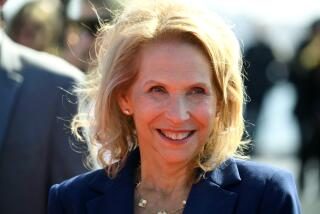Occidental Petroleum, Diamond Shamrock Call Off Plan to Merge
A $3-billion exchange of stock that would have merged Dallas-based Diamond Shamrock Corp. into Occidental Petroleum Corp. suddenly collapsed Monday, apparently because directors of the Texas oil company rejected the deal.
The proposed merger of the two firms, word of which first surfaced Friday, had been considered all but concluded after Los Angeles-based Occidental announced Monday morning that the agreement involved a 1-for-1 exchange of stock and needed only final approval of directors of both firms.
But shortly before Occidental and Diamond Shamrock executives were to hold press conferences in the early afternoon to discuss the merger, they put out a joint statement saying the deal was off.
Executives of both firms were unavailable to comment on why the agreement suddenly came apart at the last minute. But sources suggested that Diamond Shamrock Chairman William H. Bricker may have turned against the deal because he had not been guaranteed a key executive role in the combined company.
However, a Diamond Shamrock spokesman flatly denied that Bricker was dissatisfied with how he personally would be affected by the merger. The spokesman declined to elaborate and Bricker could not be reached for comment.
Occidental would have been the surviving company in the merger, with shareholders of both companies receiving stock in a new holding company to be formed by Occidental. Armand Hammer, the 86-year-old chairman of Occidental, was expected to remain as head of the combined firm, but what role Bricker would play was never made clear.
One Wall Street source said Bricker, 52, had not been guaranteed any particular job under the proposed merger agreement.
Many Analysts Cool to Plan
The firms had been discussing a merger on and off since mid-1983, shortly after Occidental President Ray Irani first joined the firm. Irani was formerly research director at Diamond Shamrock and had been directing most of the merger negotiations on behalf of Occidental.
Many Wall Street analysts had been cool to the idea of the two firms combining, noting that the emerging company would have over $5 billion in long-term debt, making it one of the most highly leveraged firms in the oil industry.
“The deal doesn’t make much sense,” said Alan Edgar, an analyst with the Dallas-based brokerage of Schneider, Bernet & Hickman Inc. Edgar speculated that the merger collapsed because directors of the two firms feared that their shareholders would not give it enthusiastic approval.
Shares of the firms were the two most actively traded issues Monday on the New York Stock Exchange. Diamond Shamrock fell $1 to close at $20 a share, while Occidental also fell $1 to $24.
Under terms of the proposal, each of Diamond Shamrock’s 126.5 million shares would have been exchanged for an Occidental share, giving the merger an indicated value of just over $3 billion, based on Occidental’s closing stock price Monday.
One source said Occidental’s directors approved the deal in a meeting that ended at about noon, and the press conference was scheduled for 2 p.m., when Hammer was expected to announce the merger.
But Diamond Shamrock’s board, meeting in Dallas, talked for more than five hours and didn’t conclude until after Occidental directors had approved the merger. A short time later, Paul Heffe, Diamond Shamrock’s director of communications, entered a crowded conference room at a Dallas hotel and told waiting reporters that the deal was off. He declined to elaborate.
Although Diamond Shamrock stockholders would originally have received a 50% premium for their stock, based on the difference in prices between shares of the two firms late last week, the stock prices had moved much closer together in trading since the merger talks were first disclosed.
The sudden similarity in the stock prices of firms that one analyst has called “the ugly ducklings of the oil industry” may have prompted Diamond Shamrock’s board to back away from the deal because stockholders had lost much of their incentive to approve it.
Analysts were divided over whether the deal would have been good for stockholders of the two companies or would have resulted in more efficient operations by combining such similar activities as coal mining, chemicals production or oil and gas exploration.
Andrew Gray, an analyst with the Wall Street firm of Pershing & Co., said the combined company, although laden with debt, would have had sufficient cash flow to both meet the higher dividend requirements and repay its long-term borrowings.
“It would dilute earnings on day one, but I think the economies of scale in coal and chemicals, combined with the possibility of selling some assets, would have made the drag on earnings short lived,” Gray said.
But analyst Edgar said the merger would have stretched Occidental’s management resources even thinner.
“Oxy is in too many businesses already,” Edgar said. “I’d rather see the company continue to sharpen up where it’s going by restructuring from within.”
Although Occidental has a good reputation for its overseas oil operations, it has not done as well with its U.S.-based oil business, analysts say. And its image has been tarnished in recent years by its money-losing coal operations, its efforts to ward off huge stock purchases by unfriendly suitors and Hammer’s inability to clearly designate an heir-apparent.
Irani, who took office in August, is the fourth president the company has had since 1979.
More to Read
Go beyond the scoreboard
Get the latest on L.A.'s teams in the daily Sports Report newsletter.
You may occasionally receive promotional content from the Los Angeles Times.










